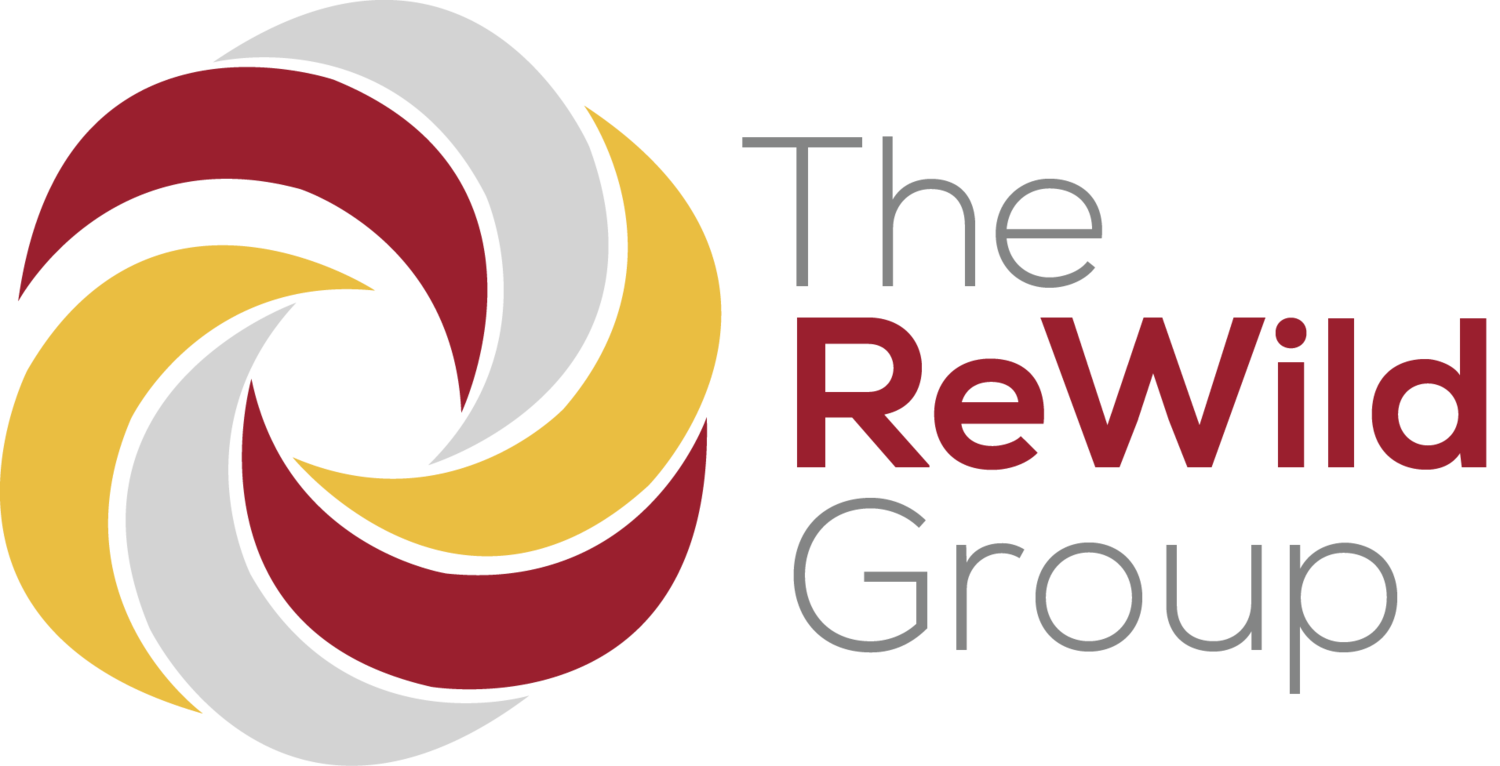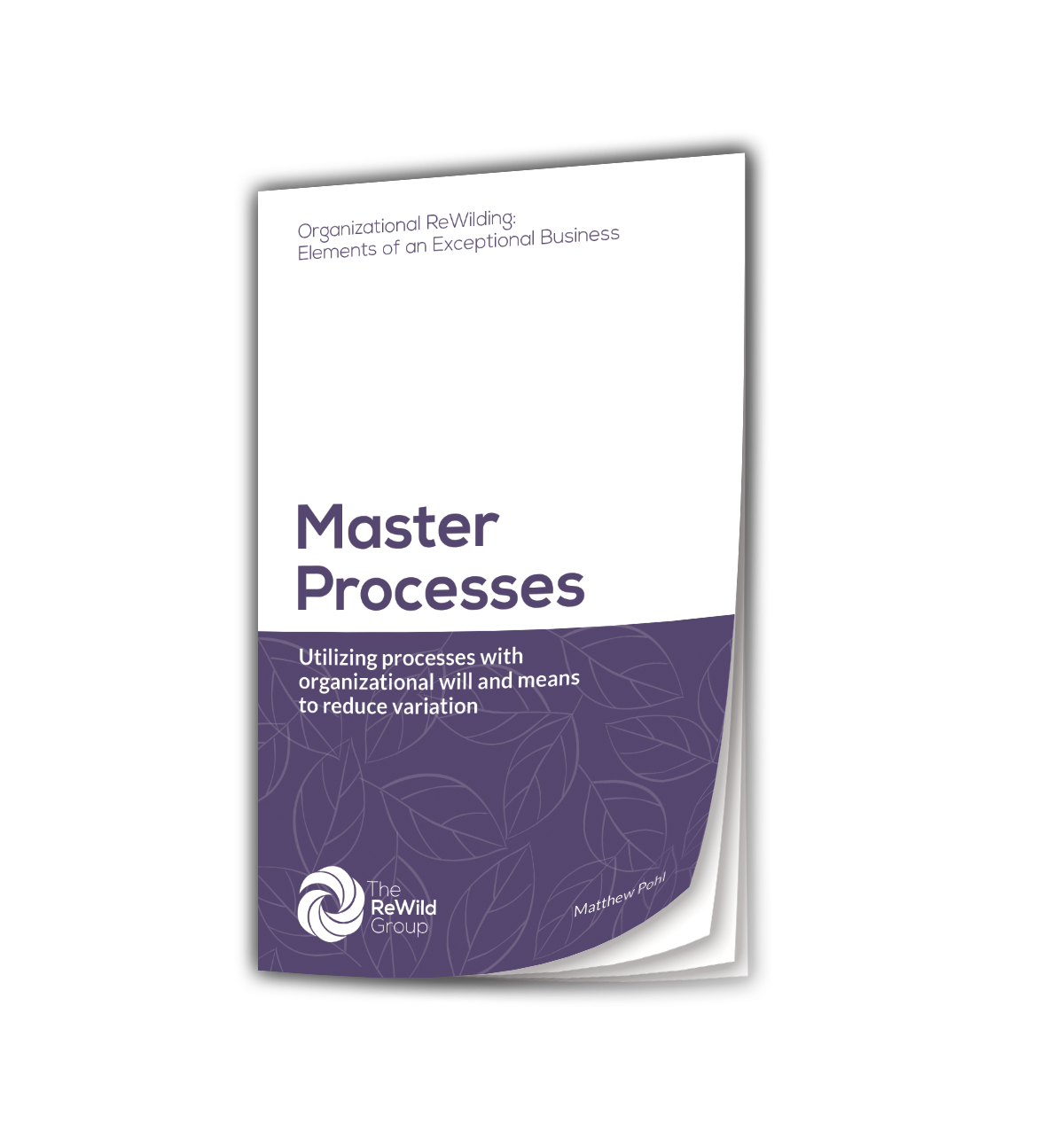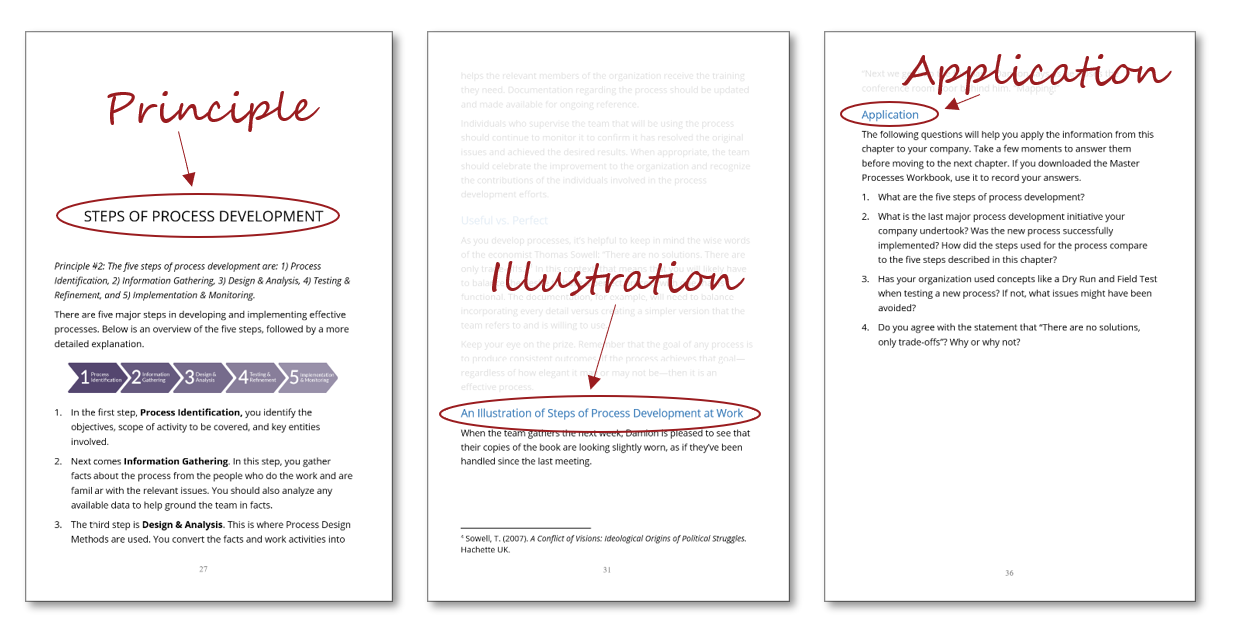The Master Processes Guidebook
Master Processes are critical to the core functions of a business—they are the engine of the organization. By focusing on Master Processes, an organization can greatly improve the quality it delivers across every area. The principles that are explained in this book pave the way toward processes that are not only effective but are actually used—and appreciated—by the people who are charged with implementing them. Practical application questions help you apply the principles to your own business.
Free Workbook Included!
The Master Processes Workbook is a free tool that will help you get the most out of the Master Processes book. A link to download the workbook can be found inside the book. The workbook includes space to take notes as well as room to record your responses to the application questions found at the end of each chapter.
Take a Look Inside
Each chapter addresses a topic related to Master Processes. The chapter begins with an explanation of the principle that is involved and follows with examples of what it looks like when the principle is applied to a business. At the end of each chapter there is an application section with questions that will help you apply the principle to your business.
“Master Processes is a quick, easy read that is packed with solid information on how a company should operate. It is written in a story format that clearly illustrates each principle and concept.”
An Overview of the Master Processes Guidebook
The book explains the principles behind Master Processes, including the five steps of process development, the four process design methods, process quality, process effectiveness, process adoption, and process improvement principles. Each chapter explores one of the principles in-depth and then illustrates how it looks when applied to Oak Ridge Landscaping. Below is an overview of the major concepts that inform Master Processes. For more details, including illustrative examples, get a copy of the book.
Enterprise Thinking
A process is defined as a series of actions or steps taken to achieve consistent outcomes. Effective processes allow an organization to perform its functions in a consistent manner regardless of which team members are involved, resulting in a product or service that is highly dependable.
The less variation that exists in the process of creating a product or delivering a service, the higher the quality. Quality is the elimination of variance. This simple yet comprehensive mindset can be applied to any type of business and any process within a business.
A Master Process differs from an ordinary process in that it is critical to the core functions of a business. Master Processes are categorized into the three primary functional areas of a business: Business Development, Operations, and Support Services.
Steps of Process Development
The five steps of process development are: 1) Process Identification, 2) Information Gathering, 3) Design & Analysis, 4) Testing & Refinement, and 5) Implementation & Monitoring.
In the first step, Process Identification, you identify the objectives, scope of activity to be covered, and key entities involved.
Next comes Information Gathering. In this step, you gather facts about the process from the people who do the work and are familiar with the relevant issues. You should also analyze any available data to help ground the team in facts.
The third step is Design & Analysis. This is where Process Design Methods are used. You convert the facts and work activities into process maps, flow charts, and checklists as appropriate. Encourage individuals who are knowledgeable about the process to provide feedback on the drafts.
With the process fully designed, it is now time to Test & Refine. Select a small number of individuals who perform the work in the process to test it in real time. It’s common that the first attempt is not completely successful and requires refinement. During refinement, you’ll determine if there need to be any improvements using several refinement criteria.
Finally, the process is ready for Implementation & Monitoring. Be sure the process documents are added to the company’s process library for ongoing use. Monitor the process to confirm it remains effective.
Process Design Methods
There are four Process Design Methods that are foundational when developing effective processes. Each one has its unique strengths and is useful at different stages of the design process.
Relational Process Maps show a process at a high level, focusing on the relationships between suppliers, customers, and departments within an organization. They do not show specific work activities or chronology.
Cross-Functional Process Maps show how work sequentially crosses between functional entities, both internal and external, from the beginning to the end of a process.
Process Flowcharts show a sequence of work activities, including actions, decision points, and iterative loops, that have a specific set of inputs and outputs.
Checklists identify key steps needed to ensure human operators consistently and completely follow a process.
Process Quality
Quality is the elimination of variance. Emphasizing the reduction or elimination of variability is a simple yet comprehensive approach to encourage good processes. The principle can be easily understood in the context of manufacturing but can also be applied to any type of business (and any process within a business). Whether it’s onboarding new employees or providing a quality experience at a restaurant, focusing on the reduction of variability helps to achieve consistent outcomes, achieving quality throughout the organization.
Process Effectiveness
The three attributes most helpful to consider when evaluating a process’s effectiveness are whether it is trainable, repeatable, and scalable. If a process fulfills these requirements, it can be considered an effective process.
A process is trainable if it can be learned and retained by people of the appropriate skill level. It should be easily understood by everyone who uses it, with the ability to be taught to someone who hasn’t used it before. In other words, it is not unnecessarily complex.
A process is repeatable if it can be performed by different people across time and achieve consistent results.
A process is scalable if it can be expanded to efficiently handle increased volume. Ideally, a process—supported by technology—will see increased efficiency as the volume increases.
Process Adoption
The success of a process depends on the people involved having both the Will and the Means to complete it. A simple Will & Means Test can be used to determine if a process will be fully adopted and consistently used by the organization.
There are three basic ways to increase Will:
Create accountability
Educate the team on why the process is important
Tie the process to individual incentives
There are also three basic ways to ensure Means:
Ensure necessary systems are in place
Eliminate any unnecessary complexity
Confirm that the process can be performed consistently
Process Improvement Principles
For an organization to gain strategic advantage based on how it performs its Master Processes, it must be committed to infusing quality into every aspect of the business. The Continual Improvement approach reflects the principle that organizations should continually undertake incremental improvements to services, products, and processes.
When creating a plan for continually improving an organization’s processes, companies often take a two-phase approach. Phase 1 consists of reviewing the company’s Master Processes. These are the processes that are critical to the core functions of a business. Phase 2 is where the organization embraces the philosophy of Continual Improvement. With the big initiatives now complete, team members need to adopt the mindset of looking for small, incremental changes. Over time, these small changes will become a transformative force for the organization.
Get the Master Processes Guidebook today!
Explore the entire Elements Book Series!
Master Processes is just one book in our series called Organizational ReWilding: 11 Elements of an Exceptional Business. Each book addresses a fundamental element of what comprises a great company.
The books are divided into four categories: Leadership, Infrastructure, Strategy, and Culture. Each one follows the same format as Master Processes, with chapters structured to explain a principle, illustrate what it looks like in practice using a fictional company, and closing with application questions designed to help you apply the principle to your own business. Click below to learn more.






